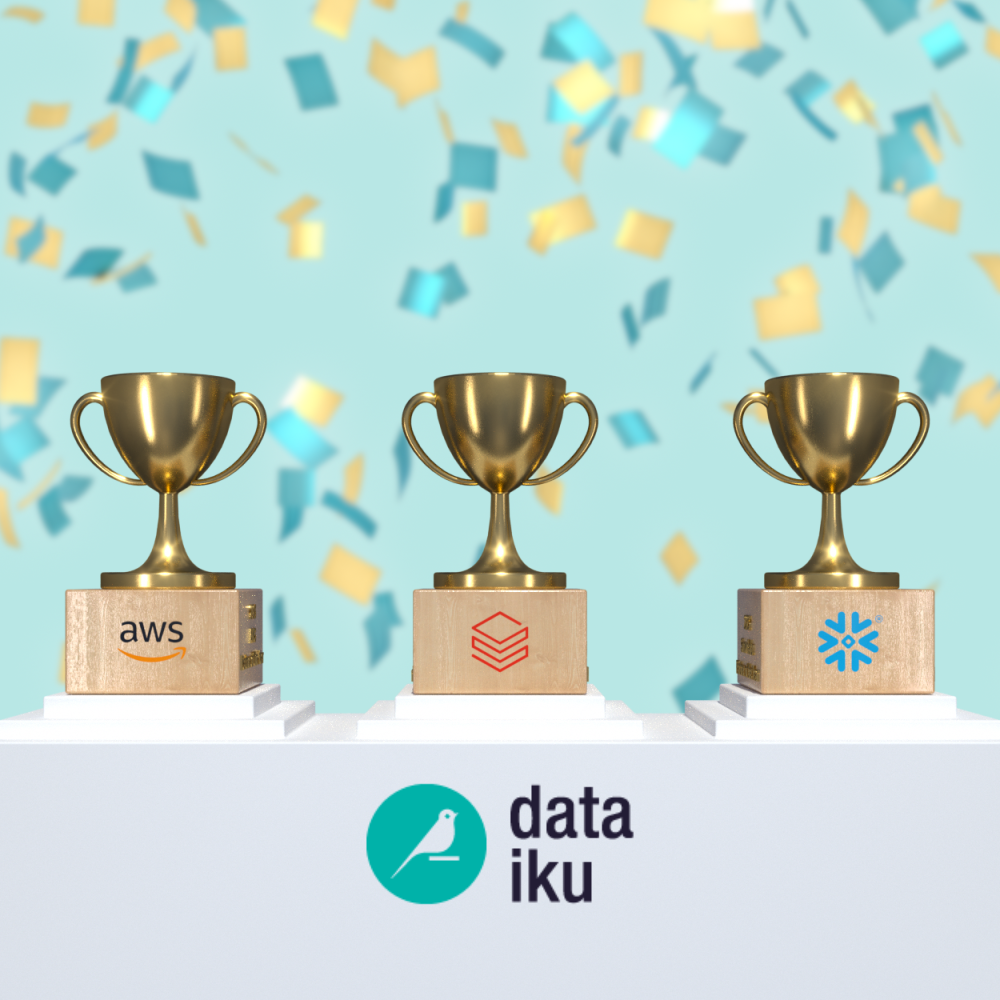Dataiku serves everyone, from business analysts and domain experts to data scientists and beyond, all within a shared interface. That means your team can work side‑by‑side on visual dashboards, machine learning projects, GenAI, and AI agents without passing files or switching platforms.
Under the hood, we support every type of data source (Snowflake, Azure, S3, BigQuery, Databricks), run analytics where the data lives using in‑database compute, and let you choose code‑free or code‑first workflows. Everything stays under governance control so IT and compliance teams know what’s happening.
The end result: Folks across business and technical roles deliver real results, without friction or ambiguity. Read on for insights into why we believe we were named a Leader in the Gartner® Magic Quadrant™ for Data Science & ML Platforms for the fourth year running.
Inside the Recognition and Why It Matters
Here are some of the key reasons why we believe Dataiku, The Universal AI Platform™, was recognized as a Leader:
1. Visionary AI innovation in the age of AI agents
We’re grounded in the fundamentals (think analytics, forecasting, segmentation, model transparency) and these are still central to how teams use Dataiku today. But we’ve also evolved, adding GenAI, the Dataiku LLM Mesh, and AI agents, with governance and lifecycle support baked in.
The LLM Mesh acts as a secure, unified gateway to thousands of LLMs (third-party, open source, and self-hosted) partnering with top GenAI providers while maintaining enterprise control. With the full suite of Dataiku LLM Guard Services, organizations can monitor usage, enforce budget limits, evaluate performance, and ensure responsible AI agent behavior over time.
2. Customer-centric support and services from day one
Most platforms hand over a toolbox and walk away. Dataiku stays close, from onboarding through scaling, to make sure your teams get to value fast. We believe we were recognized for how quickly we help customers realize value. That speaks to speedy rollouts, timely support, and adoption across roles. We enable our customers to power real results (take a sneak peek of some of those tangible results here from companies like Johnson&Johnson, BMO, Novartis, Whataburger, Perdue Farms, Prologis, Standard Chartered Bank, and more).
3. Ahead in governance and scale to ensure full enterprise control
We invested early in GenAI-specific governance features such as role‑based LLM access, RAG guardrails, trace logging, model evaluations, and compliance checks. Built‑in governance capabilities support risk assessments and bias checks throughout design, deployment, and ops.
A Real-World Example: Retail Banking and Next Best Offer
To show how the Dataiku platform works in practice, we built a retail banking use case focused on Next Best Offer solutions, featuring an AI-powered customer support portal that walked through the entire AI lifecycle in a regulated environment. Here are some of the highlights of how it played out:
Project Kickoff and Documentation
Our team used embedded wikis, to‑do lists, and detailed project summaries directly within the platform to define objectives, inputs, architecture, deliverables, and expected impact. That meant every stakeholder, from executives to engineers, had full visibility from day one.
Data Ingestion and Catalog
We brought in data from multiple systems: Azure Blob for revenue, Google BigQuery for product holdings, Databricks for transaction values, and S3 for interaction logs. Using Snowflake for scalable in‑database compute, we joined and transformed data seamlessly. Curated datasets lived in a shared data catalog with column‑level lineage, quality checks, tags, and usage metadata.
Data Preparation and GenAI Assistants
For business users, visual “prepare” recipes and AI‑assisted suggestions made cleaning and enriching data approachable. For SQL or Python users, GenAI offers code generation and iterative support in notebooks or recipes. Side note: If you’re ready to become a GenAI-powered analyst, check out how you can elevate your role with AI assistants.
In most platforms, you’re either locked into a code-heavy workflow (limiting business users) or stuck with a simplified UI (limiting depth). Dataiku lets teams move fluidly between the two (and layer in AI assistants along the way) so no one’s stuck waiting for someone else to make progress.
Modeling for all User Levels
Visual AutoML lets non‑coders run binary classification experiments, compare algorithms, tune hyper‑parameters, and publish results to dashboards. Meanwhile, Python‑savvy users could bring their own models using MLflow integrations, all within the same interface. Teams can also connect to external models from SageMaker or Databricks for centralized scoring and evaluation. Models came with explainability plots, confusion matrices, and feature importance dashboards for transparency.
Governance Embedded Throughout
We assessed risk and value prior to project launch using our governance module, enforced RAFT (Reliable, Accountable, Fair, Transparent) checkpoints, and required approvals before models or agents moved to production. Every data asset, model, or agent was tracked and documented.
AI governance isn’t just about audit trails, though. It’s how you build trust across the business. Dataiku puts tools like risk scoring, explainability, RAFT pre-checks, and role-based access right into the day-to-day workflows, so adoption and oversight go hand-in-hand.
Feature Engineering and Tagging
Crucial datasets, known as “crown jewels”, were tagged and stored in the feature store or data catalog for easy reuse. Tags made key assets discoverable and governable.
RAG‑Powered Knowledge Banks
We ingested policy documents and interaction transcripts into a knowledge bank, turning them into vector embeddings for RAG capabilities. Documents were accessed via guardrails enforcing faithfulness and relevance checks before retrieval.
Agent and Web App Creation
We built agents both via code (e.g., with LangGraph) and via visual drag‑and‑drop tools that could query models or knowledge banks. These agents appeared inside a customer support portal, an augmented chat interface where a human rep got AI‑backed suggestions, could ask clarifying questions (leveraging Dataiku Answers), approve responses, and send messages to customers. Everything was traceable with governance built in.
Testing, Monitoring, Explainability, Drift Detection
Agents could be tested in real time. All agent activity was logged and could be visually explored via Trace Explorer that rendered complex logic paths into a human‑readable flow. Conversation logs became datasets which drove GenAI evaluation recipes, surfacing accuracy, intent matches, and usage metrics.
Production Readiness
Models and agents were deployed through Dataiku Govern with version control, thresholds for model performance, and automated notifications if metrics dipped. That ensures your AI isn’t “set and forget,” but rather is governed over time.
Putting It All Together
We believe our fourth consecutive Gartner Magic Quadrant Leader placement isn't about hype, it reflects sustained execution, customer-centered design, and capability across the full AI lifecycle.
We’ve earned a 4.8 out of 5 rating on Gartner Peer Insights™, 148 of which are five-star ratings. Dataiku is trusted by 1 in 4 of the world’s top companies, based on the top 500 of the 2024 Forbes Global 2000 list (excluding China).
Because we bring analytics, models, and agents together in a unified platform, teams can benefit from accelerated deployment (most use cases go from proof of concept to deployment in weeks, not months). Because we enforce transparency, traceability, and governance at every step, enterprises can scale trust in AI and stay audit‑ready.
GARTNER is a registered trademark and service mark of Gartner and Magic Quadrant and Peer Insights are a registered trademark of Gartner, Inc. and/or its affiliates in the U.S. and internationally and are used herein with permission. All rights reserved. Gartner does not endorse any vendor, product or service depicted in its research publications, and does not advise technology users to select only those vendors with the highest ratings. Gartner research publications consist of the opinions of Gartner's research organization and should not be construed as statements of fact. Gartner disclaims all warranties, expressed or implied, with respect to this research, including any warranties of merchantability or fitness for a particular purpose. Gartner Peer Insights content consists of the opinions of individual end users based on their own experiences with the vendors listed on the platform, should not be construed as statements of fact, nor do they represent the views of Gartner or its affiliates. Gartner does not endorse any vendor, product or service depicted in this content nor makes any warranties, expressed or implied, with respect to this content, about its accuracy or completeness, including any warranties of merchantability or fitness for a particular purpose.





